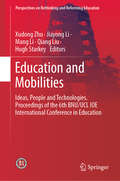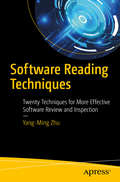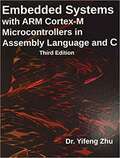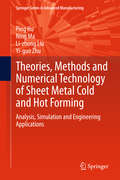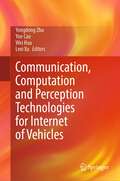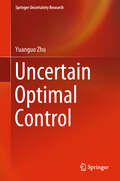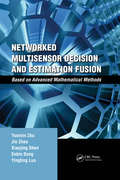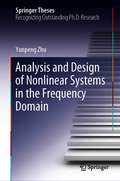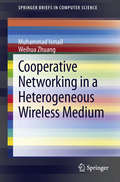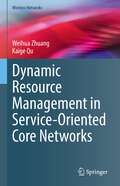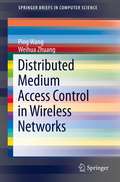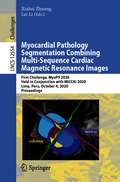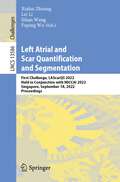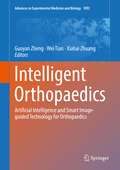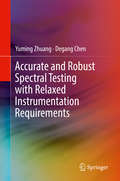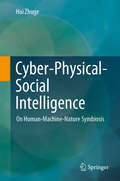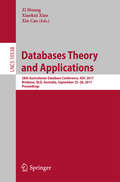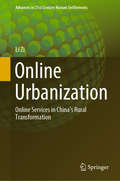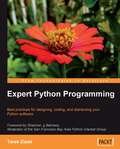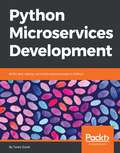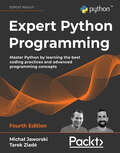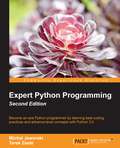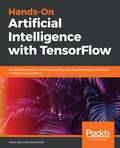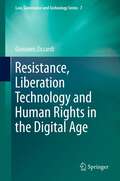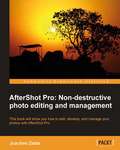- Table View
- List View
Education and Mobilities: Ideas, People and Technologies. Proceedings of the 6th BNU/UCL IOE International Conference in Education (Perspectives on Rethinking and Reforming Education)
by Xudong Zhu Mang Li Qiang Liu Hugh Starkey Jiayong LiThis book gathers selected original papers presented at the Sixth Beijing Normal University - University College London, Institute of Education International Conference in Education, a biennial event organised in partnership between this two universities. Readers will find a wealth of papers and reports on research involving schools and the initial and professional development of teachers, revealing links between research, policy and practice, while also analyzing key themes in education, including public goals and policies, pedagogy, curricula, organisation, resources and technologies, and institutional effectiveness. An essential guide for anyone who wishes to understand the main issues involved in mobilities of ideas, people and technology in the field of education, the book offers an extensive introduction, and can also be used as a resource for empirical and conceptual research into related issues.
Software Reading Techniques
by Yang‐ming ZhuLearn twenty software reading techniques to enhance your effectiveness in reviewing and inspecting software artifacts such as requirements specifications, designs, code files, and usability. Software review and inspection is the best practice in software development that detects and fixes problems early. Software professionals are trained to write software but not read and analyze software written by peers. As a result, individual reading skills vary widely. Because the effectiveness of software review and inspection is highly dependent on individual reading skills, differential outcomes among software readers vary by a factor of ten. Software Reading Techniques is designed to close that gap. Dr Yang‐Ming Zhu's depth of experience as a software architect, team leader, and scientist make him singularly well-equipped to bring you up to speed on all the techniques and tips for optimizing the effectiveness and efficiency of your software review and inspection skills. What You'll Learn: Improve software review, inspection procedures, and reading skills Study traditional and modern advanced reading techniques applicable to software artifacts Master specific reading techniques for software requirements specification, software design, and code Who This Book Is For: Software professionals and software engineering students and researchers
Embedded Systems With Arm (register Mark) Cortex-m Microcontrollers In Assembly Language And C
by Yifeng ZhuSignificant changes in the third edition include updated serial communication description (UART, SPI, and I2C), new serial communication examples, incorporation of GNU gcc compiler, low power modes, modification of example programs from STM32L1 (Cortex-M3) to STM32L4 (Cortex-M4). The book introduces basic programming of ARM Cortex-M cores in assembly and C at the register level, and the fundamentals of embedded system design. It presents basic concepts such as data representations (integer, fixed-point, floating-point), assembly instructions, stack, and implementing basic controls and functions of C language at the assembly level. It covers advanced topics such as interrupts, mixing C and assembly, direct memory access (DMA), system timers (SysTick), multi-tasking, SIMD instructions for digital signal processing (DSP), and instruction encoding/decoding. The book also gives detailed examples of interfacing peripherals, such as general purpose I/O (GPIO), LCD driver, keypad interaction, stepper motor control, PWM output, timer input capture, DAC, ADC, real-time clock (RTC), and serial communication (USART, I2C, SPI, and USB).
Theories, Methods and Numerical Technology of Sheet Metal Cold and Hot Forming
by Yi-Guo Zhu Li-Zhong Liu Ning Ma Ping HuOver the last 15 years, the application of innovative steel concepts in the automotive industry has increased steadily. Numerical simulation technology of hot forming of high-strength steel allows engineers to modify the formability of hot forming steel metals and to optimize die design schemes. Theories, Methods and Numerical Technology of Sheet Metal Cold and Hot Forming focuses on hot and cold forming theories, numerical methods, relative simulation and experiment techniques for high-strength steel forming and die design in the automobile industry. Theories, Methods and Numerical Technology of Sheet Metal Cold and Hot Forming introduces the general theories of cold forming, then expands upon advanced hot forming theories and simulation methods, including: the forming process, constitutive equations, hot boundary constraint treatment, and hot forming equipment and experiments. Various calculation methods of cold and hot forming, based on the authors' experience in commercial CAE software for sheet metal forming, are provided, as well as a discussion of key issues, such as hot formability with quenching process, die design and cooling channel design in die, and formability experiments. Theories, Methods and Numerical Technology of Sheet Metal Cold and Hot Forming will enable readers to develop an advanced knowledge of hot forming, as well as to apply hot forming theories, calculation methods and key techniques to direct their die design. It is therefore a useful reference for students and researchers, as well as automotive engineers.
Communication, Computation and Perception Technologies for Internet of Vehicles
by Yongdong Zhu Yue Cao Wei Hua Lexi XuThis book focuses on the design, management, and cybersecurity of connected and autonomous vehicles under the umbrella of the Internet of Vehicles. Both principles and engineering practice are covered, from the design perspectives of communication, computing, and perception to ITS management. An in-depth study of a range of topics such as microscopic traffic behavior modeling and simulation, localization, V2X communication, cooperative cloud-edge computing, and multi-sensor fusion for perception has been presented, while novel enabling technologies such as RIS and blockchain are introduced. The book benefits researchers, engineers, and graduate students in the fields of intelligent transport systems, telecommunications, cybersecurity, and autonomous driving.
Uncertain Optimal Control (Springer Uncertainty Research Ser.)
by Yuanguo ZhuThis book introduces the theory and applications of uncertain optimal control, and establishes two types of models including expected value uncertain optimal control and optimistic value uncertain optimal control. These models, which have continuous-time forms and discrete-time forms, make use of dynamic programming. The uncertain optimal control theory relates to equations of optimality, uncertain bang-bang optimal control, optimal control with switched uncertain system, and optimal control for uncertain system with time-delay. Uncertain optimal control has applications in portfolio selection, engineering, and games. The book is a useful resource for researchers, engineers, and students in the fields of mathematics, cybernetics, operations research, industrial engineering, artificial intelligence, economics, and management science.
Networked Multisensor Decision and Estimation Fusion: Based on Advanced Mathematical Methods
by Yunmin Zhu Jie Zhou Xiaojing Shen Enbin Song Yingting LuoDue to the increased capability, reliability, robustness, and survivability of systems with multiple distributed sensors, multi-source information fusion has become a crucial technique in a growing number of areas-including sensor networks, space technology, air traffic control, military engineering, agriculture and environmental engineering, and i
Analysis and Design of Nonlinear Systems in the Frequency Domain (Springer Theses)
by Yunpeng ZhuThis book focuses on the development of three novel approaches to build up a framework for the frequency domain analysis and design of nonlinear systems. The concepts are derived from Volterra series representation of nonlinear systems which are described by nonlinear difference or differential equations. Occupying the middle ground between traditional linear approaches and more complex nonlinear system theories, the book will help readers to have a good start to analyse and exploit the nonlinearities. Analysis and Design of Nonlinear Systems in the Frequency Domain provides clear illustrations and examples at the beginning and the end of each chapter, respectively, making it of interest to both academics and practicing engineers.
Cooperative Networking in a Heterogeneous Wireless Medium (SpringerBriefs in Computer Science)
by Weihua Zhuang Muhammad IsmailThis brief focuses on radio resource allocation in a heterogeneous wireless medium. It presents radio resource allocation algorithms with decentralized implementation, which support both single-network and multi-homing services. The brief provides a set of cooperative networking algorithms, which rely on the concepts of short-term call traffic load prediction, network cooperation, convex optimization, and decomposition theory. In the proposed solutions, mobile terminals play an active role in the resource allocation operation, instead of their traditional role as passive service recipients in the networking environment.
Dynamic Resource Management in Service-Oriented Core Networks (Wireless Networks)
by Weihua Zhuang Kaige QuThis book provides a timely and comprehensive study of dynamic resource management for network slicing in service-oriented fifth-generation (5G) and beyond core networks. This includes the perspective of developing efficient computation resource provisioning and scheduling solutions to guarantee consistent service performance in terms of end-to-end (E2E) data delivery delay. Network slicing is enabled by the software defined networking (SDN) and network function virtualization (NFV) paradigms. For a network slice with a target traffic load, the E2E service delivery is enabled by virtual network function (VNF) placement and traffic routing with static resource allocations. When data traffic enters the network, the traffic load is dynamic and can deviate from the target value, potentially leading to QoS performance degradation and network congestion. Data traffic has dynamics in different time granularities. For example, the traffic statistics (e.g., mean and variance) can be non-stationary and experience significant changes in a coarse time granularity, which are usually predictable. Within a long time duration with stationary traffic statistics, there are traffic dynamics in small timescales, which are usually highly bursty and unpredictable. To provide continuous QoS performance guarantee and ensure efficient and fair operation of the network slices over time, it is essential to develop dynamic resource management schemes for the embedded services in the presence of traffic dynamics during virtual network operation. Queueing theory is used in system modeling, and different techniques including optimization and machine learning are applied to solving the dynamic resource management problems.Based on a simplified M/M/1 queueing model with Poisson traffic arrivals, an optimization model for flow migration is presented to accommodate the large-timescale changes in the average traffic rates with average E2E delay guarantee, while addressing a trade-off between load balancing and flow migration overhead. To overcome the limitations of Poisson traffic model, the authors present a machine learning approach for dynamic VNF resource scaling and migration. The new solution captures the inherent traffic patterns in a real-world traffic trace with non-stationary traffic statistics in large timescale, predicts resource demands for VNF resource scaling, and triggers adaptive VNF migration decision making, to achieve load balancing, migration cost reduction, and resource overloading penalty suppression in the long run. Both supervised and unsupervised machine learning tools are investigated for dynamic resource management. To accommodate the traffic dynamics in small time granularities, the authors present a dynamic VNF scheduling scheme to coordinate the scheduling among VNFs of multiple services, which achieves network utility maximization with delay guarantee for each service. Researchers and graduate students working in the areas of electrical engineering, computing engineering and computer science will find this book useful as a reference or secondary text. Professionals in industry seeking solutions to dynamic resource management for 5G and beyond networks will also want to purchase this book.
Distributed Medium Access Control in Wireless Networks
by Weihua Zhuang Ping WangThis brief investigates distributed medium access control (MAC) with QoS provisioning for both single- and multi-hop wireless networks including wireless local area networks (WLANs), wireless ad hoc networks, and wireless mesh networks. For WLANs, an efficient MAC scheme and a call admission control algorithm are presented to provide guaranteed QoS for voice traffic and, at the same time, increase the voice capacity significantly compared with the current WLAN standard. In addition, a novel token-based scheduling scheme is proposed to provide great flexibility and facility to the network service provider for service class management. Also proposed is a novel busy-tone based distributed MAC scheme for wireless ad hoc networks and a collision-free MAC scheme for wireless mesh networks, respectively, taking the different network characteristics into consideration. The proposed schemes enhance the QoS provisioning capability to real-time traffic and, at the same time, significantly improve the system throughput and fairness performance for data traffic, as compared with the most popular IEEE 802.11 MAC scheme.
Myocardial Pathology Segmentation Combining Multi-Sequence Cardiac Magnetic Resonance Images: First Challenge, MyoPS 2020, Held in Conjunction with MICCAI 2020, Lima, Peru, October 4, 2020, Proceedings (Lecture Notes in Computer Science #12554)
by Xiahai Zhuang Lei LiThis book constitutes the First Myocardial Pathology Segmentation Combining Multi-Sequence CMR Challenge, MyoPS 2020, which was held in conjunction with the 23rd International Conference on Medical Image Computing and Computer-Assisted Intervention, MICCAI 2020, in Lima, Peru, in October 2020. The challenge took place virtually due to the COVID-19 crisis.The 12 full and 4 short papers presented in this volume were carefully reviewed and selected form numerous submissions. This challenge aims not only to benchmark various myocardial pathology segmentation algorithms, but also to cover the topic of general cardiac image segmentation, registration and modeling, and raise discussions for further technical development and clinical deployment.
Left Atrial and Scar Quantification and Segmentation: First Challenge, LAScarQS 2022, Held in Conjunction with MICCAI 2022, Singapore, September 18, 2022, Proceedings (Lecture Notes in Computer Science #13586)
by Xiahai Zhuang Lei Li Sihan Wang Fuping WuThis book constitutes the First Left Atrial and Scar Quantification and Segmentation Challenge, LAScarQS 2022, which was held in conjunction with the 25th International Conference on Medical Image Computing and Computer-Assisted Intervention, MICCAI 2022, in Singapore, in September 2022.The 15 papers presented in this volume were carefully reviewed and selected form numerous submissions. The aim of the challenge is not only benchmarking various LA scar segmentation algorithms, but also covering the topic of general cardiac image segmentation, quantification, joint optimization, and model generalization, and raising discussions for further technical development and clinical deployment.
Intelligent Orthopaedics: Artificial Intelligence And Smart Image-guided Technology For Orthopaedics (Advances in Experimental Medicine and Biology #1093)
by Xiahai Zhuang Wei Tian Guoyan ZhengThis book introduces readers to the latest technological advances in the emerging field of intelligent orthopaedics. Artificial intelligence and smart instrumentation techniques are now revolutionizing every area of our lives, including medicine. The applications of these techniques in orthopaedic interventions offer a number of potential benefits, e.g. reduced incision size and scarring, minimized soft tissue damage, and decreased risk of misalignment. Consequently, these techniques have become indispensable for various orthopaedic interventions, which has led to the emerging field of intelligent orthopaedics. Addressing key technologies and applications, this book offers a valuable guide for all researchers and clinicians who need an update on both the principles and practice of intelligent orthopaedics, and for graduate students embarking on a career in this field.
Accurate and Robust Spectral Testing with Relaxed Instrumentation Requirements
by Yuming Zhuang Degang ChenThis book introduces a family of new methods for accurate and robust spectral testing and fills an information gap, as the requirements in standard test have grown increasingly challenging in recent high precision testing, especially as the device performance has continued to improve. Test engineers will be enabled to accurately set their devices & systems at much simpler test setup, much reduced complexity and much lower cost.
Cyber-Physical-Social Intelligence: On Human-Machine-Nature Symbiosis (Springerbriefs In Computer Science Ser.)
by Hai ZhugeThis book explores next-generation artificial intelligence based on the symbiosis between humans, machines and nature, including the rules and emerging patterns of recognition, and the integration and optimization of various flows through cyberspace, physical space and social space. It unveils a reciprocal human-machine-nature symbiotic mechanism together with relevant rules on structuring and evolving reality, and also proposes a multi-dimensional space for modelling reality and managing the methodologies for exploring reality. As such it lays the foundation for the emerging research area cyber-physical-social intelligence. Inspiring researchers and university students to explore the development of intelligence and scientific methodology, it is intended for researchers and broad readers with a basic understanding of computer science and the natural sciences. Next-generation artificial intelligence will extend machine intelligence and human intelligence to cyber-physical-social intelligence rendered by various interactions in cyberspace, physical space and social space. With the transformational development of science and society, a multi-dimensional reality is emerging and evolving, leading to the generation and development of various spaces obeying different principles. A fundamental scientific challenge is uncovering the essential mechanisms and principles that structure and evolve the reality emerging and evolving along various dimensions. Meeting this challenge requires identifying the basic relations between humans, machines and nature in order to reveal the cyber-physical-social principles.
Databases Theory and Applications: 28th Australasian Database Conference, ADC 2017, Brisbane, QLD, Australia, September 25–28, 2017, Proceedings (Lecture Notes in Computer Science #10538)
by Zi Huang, Xiaokui Xiao and Xin CaoThis book constitutes the refereed proceedings of the 28th Australasian Database Conference, ADC 2017, held in Brisbane, QLD, Australia, in September 2017. The 20 full papers presented together with 2 demo papers were carefully reviewed and selected from 32 submissions. The mission of ADC is to share novel research solutions to problems of today’s information society that fulfill the needs of heterogeneous applications and environments and to identify new issues and directions for future research and development work. The topics of the presented papers are related to all practical and theoretical aspects of advanced database theory and applications, as well as case studies and implementation experiences.
Online Urbanization: Online Services in China’s Rural Transformation (Advances in 21st Century Human Settlements)
by Li ZiThis book highlights the new urban–rural relationship that has emerged under the influence of e-commerce in China. In this regard, it presents case studies on the Suichang rural e-commerce model and Alibaba’s rural strategy, together with analyses of online service in China. Furthermore, by means of a brief review of the urban–rural relationship throughout China’s history, and of academic literature on the study of space, it explains the special logic of urbanization in China. As such, the book makes a valuable contribution to the body of literature on the space of flows and grassrooting, aspects that are essential to appreciating the complexity of the new urban–rural relationship in underdeveloped areas (including developing countries and underdeveloped areas in developed countries) in the ongoing information era.
Expert Python Programming
by Tarek ZiadeThis book is an authoritative exploration of Python best practices and applications of agile methodologies to Python, illustrated with practical, real-world examples. This book is for Python developers who are already building applications, but want to build better ones by applying best practices and new development techniques to their projects. The reader is expected to have a sound background in Python programming.
Python Microservices Development
by Tarek ZiadeA practical approach to conquering the complexities of Microservices using the Python tooling ecosystem About This Book • A very useful guide for Python developers who are shifting to the new microservices-based development • A concise, up-to-date guide to building efficient and lightweight microservices in Python using Flask, Tox, and other tools • Learn to use Docker containers, CoreOS, and Amazon Web Services to deploy your services Who This Book Is For This book is for developers who have basic knowledge of Python, the command line, and HTTP-based application principles, and those who want to learn how to build, test, scale, and manage Python 3 microservices. No prior experience of writing microservices in Python is assumed. What You Will Learn • Explore what microservices are and how to design them • Use Python 3, Flask, Tox, and other tools to build your services using best practices • Learn how to use a TDD approach • Discover how to document your microservices • Configure and package your code in the best way • Interact with other services • Secure, monitor, and scale your services • Deploy your services in Docker containers, CoreOS, and Amazon Web Services In Detail We often deploy our web applications into the cloud, and our code needs to interact with many third-party services. An efficient way to build applications to do this is through microservices architecture. But, in practice, it's hard to get this right due to the complexity of all the pieces interacting with each other. This book will teach you how to overcome these issues and craft applications that are built as small standard units, using all the proven best practices and avoiding the usual traps. It's a practical book: you'll build everything using Python 3 and its amazing tooling ecosystem. You will understand the principles of TDD and apply them. You will use Flask, Tox, and other tools to build your services using best practices. You will learn how to secure connections between services, and how to script Nginx using Lua to build web application firewall features such as rate limiting. You will also familiarize yourself with Docker's role in microservices, and use Docker containers, CoreOS, and Amazon Web Services to deploy your services. This book will take you on a journey, ending with the creation of a complete Python application based on microservices. By the end of the book, you will be well versed with the fundamentals of building, designing, testing, and deploying your Python microservices. Style and approach This book is an linear, easy-to-follow guide on how to best design, write, test, and deploy your microservices. It includes real-world examples that will help Python developers create their own Python microservice using the most efficient methods.
Expert Python Programming: Master Python by learning the best coding practices and advanced programming concepts, 4th Edition
by Tarek Ziade Michal JaworskiAttain a deep understanding of building, maintaining, packaging, and shipping robust Python applicationsKey FeaturesDiscover the new features of Python, such as dictionary merge, the zoneinfo module, and structural pattern matchingCreate manageable code to run in various environments with different sets of dependenciesImplement effective Python data structures and algorithms to write, test, and optimize codeBook DescriptionPython is used in a wide range of domains owing to its simple yet powerful nature. Although writing Python code is easy, making it readable, reusable, and easy to maintain can be challenging. Complete with best practices, useful tools, and standards implemented by professional Python developers, this fourth edition will help you in not only overcoming such challenges but also learning Python's latest features and advanced concepts. The book begins with a warm-up, where you will catch-up with the latest Python improvements, syntax elements, and interesting tools to boost your development efficiency. Further, the initial few chapters should allow experienced programmers coming from different languages to safely land in the Python ecosystem. As you progress, you will explore common software design patterns and various programming methodologies, such as event-driven programming, concurrency, and metaprogramming. You will also go through complex code examples and try to solve meaningful problems by bridging Python with C and C++, writing extensions that benefit from the strengths of multiple languages. Finally, you will understand the complete lifetime of any application after it goes live. By the end of the book, you should be proficient in writing efficient and maintainable Python code.What you will learnExplore modern ways of setting up repeatable and consistent Python development environmentsEffectively package Python code for community and production useLearn about modern syntax elements of Python programming, such as f-strings, dataclasses, enums, and lambda functionsDemystify metaprogramming in Python with metaclassesWrite concurrent code in PythonMonitor and optimize the performance of Python applicationExtend and integrate Python with code written in different languagesWho this book is forThe Python programming book is intended for expert programmers who want to learn Python's advanced-level concepts and latest features.Anyone who has basic Python skills should be able to follow the content of the book, although it might require some additional effort from less experienced programmers. It should also be a good introduction to Python 3.9 for those who are still a bit behind and continue to use other older versions.
Expert Python Programming - Second Edition
by Tarek Ziade Michal JaworskiBecome an ace Python programmer by learning best coding practices and advance-level concepts with Python 3.5 About This Book * Based on the latest stable version of Python (version 3.5) * Creating well manageable code that will run in various environments with different sets of dependencies * Packed with advanced concepts and best practices to write efficient Python code Who This Book Is For The book would appeal to web developers and Python programmers who want to start using version 3.5 and write code efficiently. Basic knowledge of Python programming is expected. What You Will Learn * Conventions and best practices that are widely adopted in the python community * Package python code effectively for community and production use * Easy and lightweight ways to automate code deployment on remote systems * Improve your code's quality, reliability, and performance * Write concurrent code in python * Extend python with code written in different languages In Detail Python is a dynamic programming language, used in a wide range of domains by programmers who find it simple, yet powerful. Even if you find writing Python code easy, writing code that is efficient and easy to maintain and reuse is a challenge. The focus of the book is to familiarize you with common conventions, best practices, useful tools and standards used by python professionals on a daily basis when working with code. You will begin with knowing new features in Python 3.5 and quick tricks for improving productivity. Next, you will learn advanced and useful python syntax elements brought to this new version. Using advanced object-oriented concepts and mechanisms available in python, you will learn different approaches to implement metaprogramming. You will learn to choose good names, write packages, and create standalone executables easily. You will also be using some powerful tools such as buildout and vitualenv to release and deploy the code on remote servers for production use. Moving on, you will learn to effectively create Python extensions with C, C++, cython, and pyrex. The important factors while writing code such as code management tools, writing clear documentation, and test-driven development are also covered. You will now dive deeper to make your code efficient with general rules of optimization, strategies for finding bottlenecks, and selected tools for application optimization. By the end of the book, you will be an expert in writing efficient and maintainable code. Style and approach An easy-to-follow guide that covers industry followed best practices in Python programming
Hands-On Artificial Intelligence with TensorFlow: Useful techniques in machine learning and deep learning for building intelligent applications
by Amir Ziai Ankit DixitExploit TensorFlow's capabilities to build artificial intelligence applicationsKey FeaturesExploit TensorFlow's new features to power your artificial intelligence appsImplement machine learning, deep learning, and reinforcement learning models with TensorflowBuild intelligent applications for computer vision, NLP, and healthcare, among othersBook DescriptionArtificial Intelligence (AI) is a popular area with an emphasis on creating intelligent machines that can reason, evaluate, and understand the same way as humans. It is used extensively across many fields, such as image recognition, robotics, language processing, healthcare, finance, and more.Hands-On Artificial Intelligence with TensorFlow gives you a rundown of essential AI concepts and their implementation with TensorFlow, also highlighting different approaches to solving AI problems using machine learning and deep learning techniques. In addition to this, the book covers advanced concepts, such as reinforcement learning, generative adversarial networks (GANs), and multimodal learning.Once you have grasped all this, you’ll move on to exploring GPU computing and neuromorphic computing, along with the latest trends in quantum computing. You’ll work through case studies that will help you examine AI applications in the important areas of computer vision, healthcare, and FinTech, and analyze their datasets. In the concluding chapters, you’ll briefly investigate possible developments in AI that we can expect to see in the future.By the end of this book, you will be well-versed with the essential concepts of AI and their implementation using TensorFlow.What you will learnExplore the core concepts of AI and its different approachesUse the TensorFlow framework for smart applicationsImplement various machine and deep learning algorithms with TensorFlowDesign self-learning RL systems and implement generative modelsPerform GPU computing efficiently using best practicesBuild enterprise-grade apps for computer vision, NLP, and healthcareWho this book is forHands-On Artificial Intelligence with TensorFlow is for you if you are a machine learning developer, data scientist, AI researcher, or anyone who wants to build artificial intelligence applications using TensorFlow. You need to have some working knowledge of machine learning to get the most out of this book.
Resistance, Liberation Technology and Human Rights in the Digital Age
by Giovanni ZiccardiThis book explains strategies, techniques, legal issues and the relationships between digital resistance activities, information warfare actions, liberation technology and human rights. It studies the concept of authority in the digital era and focuses in particular on the actions of so-called digital dissidents. Moving from the difference between hacking and computer crimes, the book explains concepts of hacktivism, the information war between states, a new form of politics (such as open data movements, radical transparency, crowd sourcing and "Twitter Revolutions"), and the hacking of political systems and of state technologies. The book focuses on the protection of human rights in countries with oppressive regimes.
Aftershot Pro: Non-destructive photo editing and management
by Joachim ZiebsThe book takes a tutorial approach.This book is great for photographers who want to start working with AfterShot Pro. It is assumed that you have a digital camera that can save RAW files to make use of the application. Readers are expected to have one or more RAW files available which can be used for practice alongside this book. Experience with other image editing software is a plus, but not mandatory for this book.
